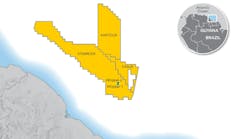In May of this year, Oil & Gas UK published an update to its BOP System Guidelines with the aim of describing good practices for subsea and offshore surface BOP operations on the UK continental shelf. The intent of the guidelines, which were written by the BOP Issues Work Group of the Well Life Cycle Practices Forum, is to help drilling contractors and well operators comply with legislation relevant to BOPs, diverter systems, and mud gas separators.
The UK HSE approach to regulations in the context of deepwater has changed from one of prescriptive requirements to one of goal-setting, which is an approach to safety that is now being adopted worldwide for complex offshore operations. In the case of the BOP System Guidelines, responsibility for assessing and controlling risks is placed on the installation duty holder and the well operator (the companies with the greatest influence on operations).
This is a fundamental change in culture and process. It represents a move from a tick-the-box approach to meeting requirements, to an approach that requires operational performance proving activities are being carried out safely.
The move toward performance-based safety has resulted in safety improvement in deepwater operations where the consequences and cost of an incident can be catastrophic. These changes are moving the safety of the oil and gas industry forward. However, there is an element of safety that regulations do not adequately address, and that is human error.
Despite the many system safeguards in place, there is no escaping the fact that many incidents are attributable to human error. An accepted figure is that 80% involve human error in one way or another.
It would be inaccurate to imply that human involvement in operations has been ignored by the oil and gas industry. Certainly, some human factors are taken into account in the design and operation of offshore systems. Numerous companies have their own ergonomic safety in design standards and follow some US and international guidelines like ASTM F1166, Standard Practice for Human Engineering Design for Marine Systems, Equipment, and Facilities. Classification societies also offer an assortment of recommendations. ABS, for example, recently issued a human factors engineering implementation guideline for offshore facilities design, the first of its kind in the offshore industry. Meanwhile, risk analyses capture some human factors issues, but this does not represent a full systematic approach and relies heavily on the experience of HAZID and HAZOP teams for success.
Safety regulations often mention "consideration of human factors," but often, what constitutes "human factors" is not clearly defined. While other industries have made progress in looking at the human operator as a system component, this consideration is not widespread in oil and gas. Unfortunately, the result is that the oil and gas industry is years behind other complex industries like aerospace and nuclear power generation in human factors integration.
With human factors engineering (HFE) being relatively new to the oil and gas industry, there are few practitioners, and as a result, human error producing designs are not identified or corrected during the design process. This is not the fault of the design engineer or management. The issue is that few members of design teams receive training related to HFE, its role, its benefits, or its integration into the design. With the number of incidents that can be traced back to human error, there is an evident need for HFE.
HFE is the scientific discipline concerned with understanding interactions between humans and elements of a system; and the profession that applies theory, principles, data, and methods of design to optimize human wellbeing and overall system performance. Examples include human-machine integration, equipment automation, alarm management, valve criticality, materials handling, emergency escape and rescue, and control room design and layout.
Integrating HFE with other engineering disciplines helps ensure that designs effectively match human capabilities and limitations, with system requirements to create operational hardware and software that reduce the potential for human error and increase overall system availability while improving human performance and system safety.
For decades, the offshore industry has striven to achieve a safer workplace. During the last few years, segments of the offshore industry have concentrated more on reducing human error as a way to enhance safety. As a result, they are becoming more aware of – and are responding to – the important role of the HFE within effective safety standards and practices.
Experience shows that integrating HFE design practices and principles into new projects has resulted in installations that are safer, more cost effective and easier to operate and maintain. Experience also shows that the sooner HFE is proactively integrated into a design cycle, the more cost effective the project becomes and the greater the positive impact HFE has on business performance.
Dave Hollaway
Human Factors Engineering Manager
ABS Group
This page reflects viewpoints on the political, economic, cultural, technological, and environmental issues that shape the future of the petroleum industry. Offshore Magazine invites you to share your thoughts. Email your Beyond the Horizon manuscript to David Paganie at[email protected].




